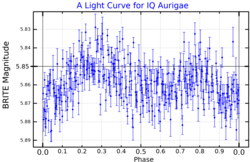IQ Aurigae
 A light curve for IQ Aurigae from BRITE nanosatellites. Plotted from data published by Strassmeier et al. (2020),[1] assuming a period of 2.463 days. | |
| Observation data Epoch J2000 Equinox J2000 | |
|---|---|
| Constellation | Auriga |
| Right ascension | 05h 19m 00.02846s[2] |
| Declination | +33° 44′ 54.2208″[2] |
| Apparent magnitude (V) | 5.38[3] |
| Characteristics | |
| Evolutionary stage | main sequence[4] |
| Spectral type | A0pSi[5] |
| U−B color index | −0.62[6] |
| B−V color index | −0.167±0.004[3] |
| Variable type | α2 CVn[7] |
| Astrometry | |
| Radial velocity (Rv) | +28.6[8] km/s |
| Proper motion (μ) | RA: +13.573[2] mas/yr Dec.: −29.028[2] mas/yr |
| Parallax (π) | 7.0526 ± 0.1065 mas[2] |
| Distance | 462 ± 7 ly (142 ± 2 pc) |
| Absolute magnitude (MV) | −0.42[9] |
| Details[9] | |
| Mass | 3.95±0.21 M☉ |
| Radius | 2.6±0.4 R☉ |
| Luminosity | 263 L☉ |
| Surface gravity (log g) | 4.34±0.12 cgs |
| Temperature | 14,454 K |
| Metallicity [Fe/H] | 1.70[10] dex |
| Rotation | 2.4660 days |
| Rotational velocity (v sin i) | 49 km/s |
| Age | 6.3[4] Myr |
| Other designations | |
| Database references | |
| SIMBAD | data |
IQ Aurigae is a (most likely) single,[4] variable star in the northern constellation of Auriga. It is visible to the naked eye as a dim, white-hued star with an apparent visual magnitude that fluctuates around 5.38.[3] The star is located at a distance of about 460 light-years from the Sun based on parallax and is drifting further away with a radial velocity of +28.6 km/s.[8]
In 1953, Sanford S Provin reported that the star, referred to at that time as HD 34452, showed indications of being a variable star, but the evidence was inconclusive.[12] Karl D. Rakos confirmed that the star is variable in 1962.[13]
This is a magnetic Ap star with a stellar classification of A0pSi.[4] It is known as a silicon star, having a strong line of singly ionized silicon, and may also be helium deficient as the lines of helium are weaker than expected.[10] The star is an Alpha2 Canum Venaticorum-type variable, ranging in magnitude from 5.35 down to 5.43 with a rotationally-modulated period of 2.4660 days.[7] It is an X-ray source with a high luminosity of 4×1029 erg s−1, which may be caused by a combination of shocks in the stellar wind and magnetic reconnection occurring well above the stellar surface. The star has been observed to flare, during which the X-ray emission rose to 3.2×1031 erg s−1.[4]
IQ Aurigae is 6.3[4] million years old and is spinning with a projected rotational velocity of 49 km/s, giving it a rotation period of 2.47 days.[9] It has nearly four times the mass of the Sun and 2.6 times the Sun's radius. The star is radiating 263 times the luminosity of the Sun from its active photosphere at an effective temperature of 14,454 K.[9]
References
[edit]- ^ Strassmeier, K. G.; Granzer, T.; Weber, M.; Kuschnig, R.; Pigulski, A.; Popowicz, A.; Moffat, A. F.; Wade, G. A.; Zwintz, K.; Handler, G. (December 2020), "BRITE photometry and STELLA spectroscopy of bright stars in Auriga: Rotation, pulsation, orbits, and eclipses", Astronomy & Astrophysics, 644: A104, arXiv:2010.10092, doi:10.1051/0004-6361/202039310, S2CID 224803974.
- ^ a b c d e Vallenari, A.; et al. (Gaia collaboration) (2023). "Gaia Data Release 3. Summary of the content and survey properties". Astronomy and Astrophysics. 674: A1. arXiv:2208.00211. Bibcode:2023A&A...674A...1G. doi:10.1051/0004-6361/202243940. S2CID 244398875. Gaia DR3 record for this source at VizieR.
- ^ a b c Anderson, E.; Francis, Ch. (2012), "XHIP: An extended hipparcos compilation", Astronomy Letters, 38 (5): 331, arXiv:1108.4971, Bibcode:2012AstL...38..331A, doi:10.1134/S1063773712050015, S2CID 119257644.
- ^ a b c d e f Robrade, J.; Schmitt, J. H. M. M. (July 2011), "New X-ray observations of IQ Aurigae and α2 Canum Venaticorum. Probing the magnetically channeled wind shock model in A0p stars", Astronomy & Astrophysics, 531: 11, arXiv:1105.3688, Bibcode:2011A&A...531A..58R, doi:10.1051/0004-6361/201116843, S2CID 119245911, A58.
- ^ Cowley, A.; et al. (April 1969), "A study of the bright A stars. I. A catalogue of spectral classifications", Astronomical Journal, 74: 375–406, Bibcode:1969AJ.....74..375C, doi:10.1086/110819.
- ^ Mermilliod, J.-C. (1986), "Compilation of Eggen's UBV data, transformed to UBV (unpublished)", Catalogue of Eggen's UBV Data. SIMBAD, Bibcode:1986EgUBV........0M.
- ^ a b Samus', N. N; et al. (2017), "General catalogue of variable stars: Version GCVS 5.1", Astronomy Reports, 61 (1): 80, Bibcode:2017ARep...61...80S, doi:10.1134/S1063772917010085, S2CID 125853869.
- ^ a b Gontcharov, G. A. (November 2006), "Pulkovo Compilation of Radial Velocities for 35 495 Hipparcos stars in a common system", Astronomy Letters, 32 (11): 759–771, arXiv:1606.08053, Bibcode:2006AstL...32..759G, doi:10.1134/S1063773706110065, S2CID 119231169.
- ^ a b c d North, P. (June 1998), "Do SI stars undergo any rotational braking?", Astronomy and Astrophysics, 334: 181–187, arXiv:astro-ph/9802286, Bibcode:1998A&A...334..181N.
- ^ a b Tomley, L. J.; et al. (December 1970), "A spectroscopic analysis of the silicon star HD 34452.", Astronomy and Astrophysics, 9: 380–391, Bibcode:1970A&A.....9..380T.
- ^ "IQ Aur". SIMBAD. Centre de données astronomiques de Strasbourg. Retrieved 2019-08-17.
- ^ Provin, Sanford S. (November 1953). "Light-Variations of Peculiar A Stars". Astrophysical Journal. 118: 489–501. Bibcode:1953ApJ...118..489P. doi:10.1086/145777. Retrieved 29 November 2024.
- ^ Rakos, Karl D. (1962). "Photoelectric investigation of magnetic and spectrum variable stars". Bulletin / Lowell Observatory no. 117. 5 (12). Bibcode:1962LowOB...5..227R. Retrieved 29 November 2024.
